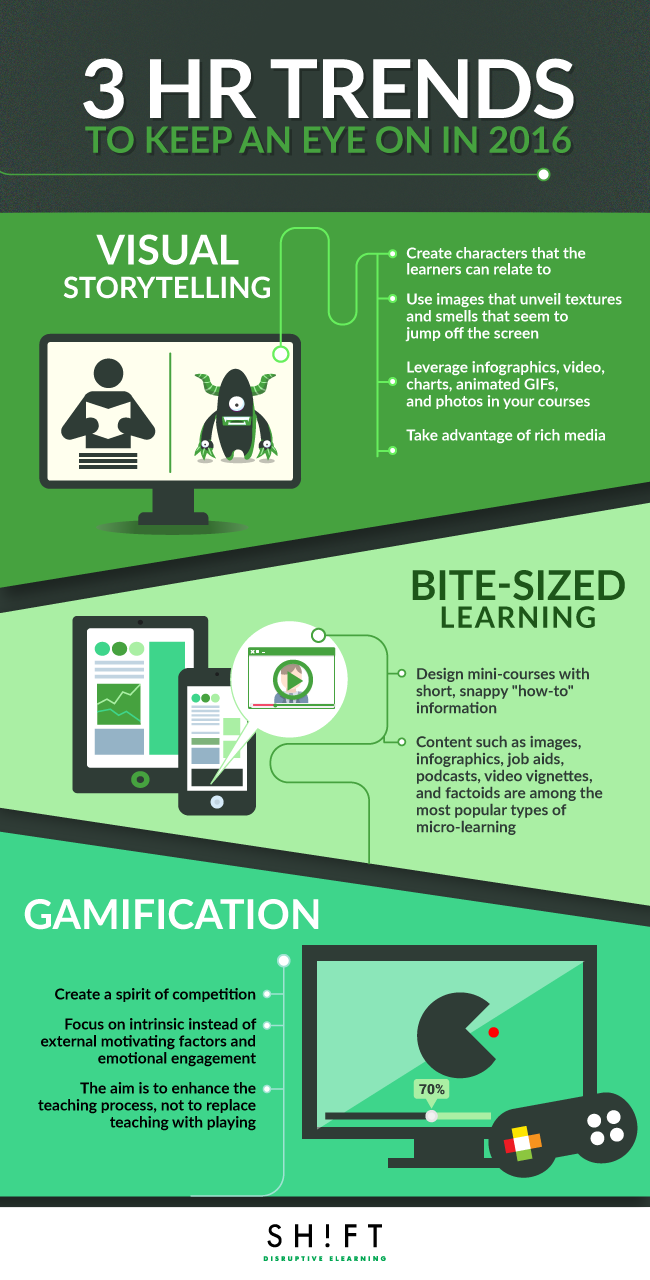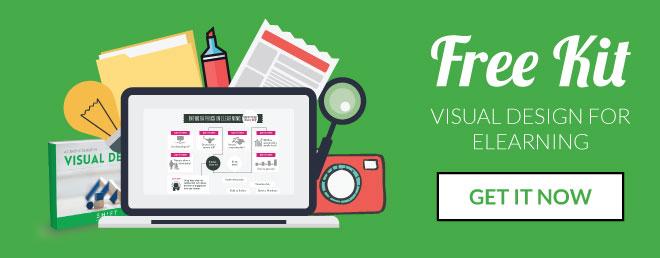This article by Doug Howard in Training Industry Magazine aptly sums up the hot trends that have dominated the HR industry this year. We believe that some of these trends should also be picked up and implemented by learning and development professionals next year too. After all, we design for employees; it helps if we know what motivates them to perform better at the workplace and how we can keep them hooked to the courses that training managers and the C-suite commission spend thousands of dollars on to create.
Here are 3 growing HR trends training managers and L&D professionals can't ignore next year. By following these, you are addressing these needs of the modern learner.

1) Visual Storytelling is Here to Stay
In today's world, we have to work harder to be relevant and grab our learner's attention. The written word is no longer our 'default setting.' We need to be paying more attention to the art of visual storytelling. Wrapping content with powerful visuals and a story helps present content in an easy to understand and attractive way.
We can’t simply slap a few stock photos onto our eLearning courses anymore, we've got to create bite-sized stories that connect the different photos together in a story that tug at our learners heartstrings.
Here are some ways to engage learners with visual storytelling:
- Create characters that the learners can relate to. Why not use a friendly character to tell your company's founding story to new employees?
- To emphasize a story, you can use a hero image to direct people's attention towards that specific story.
- Use images that unveil textures and smells that seem to jump off the screen.
- Take advantage of rich media to not only tell a story but also bring it alive. Besides, the more the senses you engage while storytelling, the more the lessons will stick in the learner’s mind.
- Leverage infographics, charts, animated GIFs, and photos in your courses. Make sure you use the right mix of visuals to appeal your learner's emotions.
- With the explosive growth of video in 2015, videos are also a great way of getting your message in front of your learners.
2) Bite-sized Learning is Our Present and Future
"Microlearning enables alignment and engagement in a way that solves the C-suite’s greatest problems and makes it less likely learning will be cut when the belt tightens." CLOMEDIA
Bite-sized learning, also known as micro-learning is an unstoppable movement in the corporate training field today. According to a recent study by the Rapid Learning Institute, nearly nine out of ten learning professionals want to provide more short-form learning.
The benefits over linear, long-form eLearning courses are many: improved psychological engagement and knowledge retention, deeper manager involvement, better business results ( faster, cheaper and easier to produce), and compatibility with mobile usage habits.
Bite-sized learning is ideal for the just-in-time, on-the-go learning requirements of today’s workforce. Learners are swimming in the vast sea of information. They're inundated with data coming from various devices, with messages on different chat apps, with a stream of social statuses. They do not want to be tethered to their desk and made to go through an hour or two-hour-long eLearning course. They want amazingly designed mini-courses with short, snappy "how-to" information that gives them a feeling of progress.... and that can be accessed 24/7. Content such as images, infographics, job aids, podcasts, video vignettes, and factoids are among the most popular types of micro-learning.
Meanwhile, below are some tips to help you get started with microlearning:
- Cut to the chase right away. According to studies, in 2000 the average attention span was twelve seconds, but this has now fallen to just eight. Learners aren't fond of tedious courses that seem to go on endlessly.
- Chunk content smartly. One way to keep your course fluff-free is to do away with all the inessentials. Think like this: if some piece of information will not help the learner at the workplace, then it has no place in the course.
- Use short videos. Here’s a rule of thumb to help you create short microlearning videos: keep them to 4 minutes or less and have 120 words or less for every minute of video. Here’s a resource to help you create a crisp microlearning video.
Read: Is Microlearning The Solution You Need?
3) Gamification and Game-based Learning Are Getting Hotter Every Day
"Gamification is changing the very DNA of HR. One must know everything about the game one is playing and be the best at it to ensure one’s life is the best — now is the time to play." Prithvi Shergill, Chief Human Resources Officer at HCL Technologies
Since 2011, Gamification" has been a buzzword. However, in 2015, Gamification is hotter than ever. This trend will keep gaining momentum as companies look for new ways to attract and motivate employees to complete training programs (mandatory, soft skills and other compliance programs especially.) Several studies support this view. According to the 2013-2018 North America Mobile Edugame Market Report by Ambient Insight, the revenues from game-based mLearning products, with a CAGR of 12.5 percent, will be $410.27 million by 2018 in North America alone.
Adult learners love to be part of what is happening around them and want to control the action. Playing games let them fulfill these intrinsic emotional needs. When we deliver learning through games, we hook learners immediately and draw them into the course in a way that mere text or visuals cannot. What is more, games are more result-oriented, which is a feature that particularly intrigues adult learners who are focused and want to know that their actions have not gone to waste.
But before gamifying an eLearning course, keep the following in mind:
- Create a spirit of competition. Millennials are competitive, and they are more motivated to engage with your course if there are rewards in sight. However, the kinds of reward that entice adult learners are not badges and medals; your learner will be motivated to play a game if you can convince him that he will find the solution to his workplace problem at the end of the game.
- When gamifying eLearning, remember that use of game elements is not same as creating a game for the content. The aim is to enhance the teaching process and hence make it more fun and engaging but not to replace teaching with playing.
- Focus on intrinsic instead of external motivating factors and emotional engagement.
- Gartner reports that 80% of gamified applications will fail if not designed correctly. So, consider whether gamification can harmoniously fit in with your training and eLearning strategy before investing in it.
Go over these examples and case studies:
- 4 Innovative Companies That Gamified eLearning
- Future of Work: Using Gamification For Human Resources
- Gamification: What can it bring to HR?
- 3 Success Stories of Gamification in HR
The HR trends mentioned above have caught on because these strategies and solutions address the needs of millennial employees. Corporations have realized that they now need to have concrete and focused strategies to keep their employees engaged and stimulated and promote their welfare to retain talent.
Are you keeping up with these trends?



